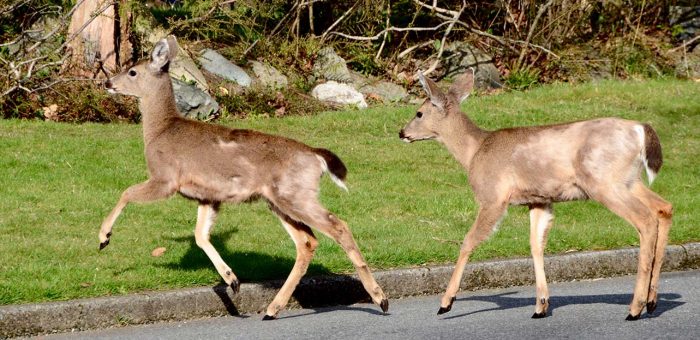Celebrating the SPCA Wild Animal Rehabilitation Centre
Tonight I had the distinct honour of providing the opening remarks at the BC SPCA Spring into Wildlife celebration of the Wild Animal Rehabilitation Centre (Wild ARC). I took this opportunity to explore the innovative work being done by the District of Oak Bay, in partnership with the Urban Deer Stewardship Society and the Province of British Columbia, to introduce an evidence-based approach to urban deer management.
Below I reproduce the text of my remarks.
Text of my Remarks
Thank you for inviting me to attend this evening of celebration of the work of BC SPCA’s wild animal rehabilitation centre, as well as for providing me with the opportunity to offer some remarks about urban wildlife.
As the MLA for Oak Bay-Gordon Head, I often hear from constituents and community groups about the urban deer population. To address the situation properly we have to look at the root causes.
Human development has, over time, increasingly destroyed the deer’s natural habitat. In addition, their new habitat in our neighbourhoods removes many of their natural predators. As a result the local deer population has increased substantially. What was once a novelty to see is now an everyday occurrence.
It’s rare if we don’t see groups of deer as we walk, bike or drive around town. When we see one deer cross the road, we are extra vigilant for others, especially the fawns and yearlings usually following close behind.
The species of urban deer common in our area is the Columbian Black-tailed Deer. These deer are native to North America and have adapted to a variety of ecosystems over thousands of years. They have managed to adapt to our urban habitat and continue to share our beautiful, green urban landscape.
I am a big supporter of the District of Oak Bay’s approach to deer management through their plan for a contraception program. Oak Bay Council first adopted this approach in late 2016 and I worked with council to ensure they had access to provincial resources to initiate it.
What resulted was a three-way partnership between Oak Bay, the Province of BC and the non-profit Urban Wildlife Stewardship Society (UWSS). The Province provided the partnership with cost shared funding to research and test non-lethal, evidence-based methods of reducing the urban deer population.
UWSS operates under a provincial wildlife permit, which can only be granted if the project meets stringent animal care regulations and requirements.
The latest estimates indicate a local deer population of between 72 and 128 deer.
The contraceptive regimen won’t eliminate our deer population. The hope is that the population will level out and then start declining. Patience is required but it is the humane thing to do.
It’s good to see this program underway.
As you might imagine, I believe that it’s inhumane to sit back and watch our urban deer die horrible lingering deaths due to car collisions. We know that the number of deer hit by cars has increased. In 2010, 8 deer were killed in Oak Bay by cars. That figure had increased to 48 in 2017. For the last 3 years, there have been more than 40 deer carcasses picked up annually by municipal staff in Oak Bay.
In my view, a cull of deer is not the answer. The contraceptive program is much more humane. Our urban deer, by nature, have absolutely no concern for municipal borders.
If there were to be another cull of deer in Oak Bay (one previous deer cull in 2015 totalled 11 deer), the space created would quickly be filled by deer in neighbouring areas. Paradoxically, a cull would likely increase the local deer population as Kelowna demonstrated. After five years of culling, the deer population actually increased by 36% there.
The Urban Wildlife Stewardship Society adheres to the principles of Compassionate Conservation. Humane treatment is their utmost priority. They have the support of the BC SPCA, the Victoria Human Society and they cooperate with BC’s provincial veterinarian who oversees all wildlife care for the entire province.
I look forward to hearing from UWSS about the progress of this contraception program and fully support their non-lethal approach to wildlife stewardship. Their work is evidence-based, utilizing leading-edge scientific tools. You can see the most recent report from UWSS on the District of Oak Bay website.
Expanding on the urban wildlife in my local district to the provincial challenges that arise when humans encroach on animal’s habitats, I also wanted to take a moment to reference some of the work my BC Green colleagues and I are doing at the legislature to protect wildlife.
Soon after the 2017 election we became the go-to office for people worried about their local ecosystem. We quickly learned that we didn’t have the capacity to intervene on each case, so we channelled our efforts into tackling the overarching, systemic issues that were causing these local problems: inadequate habitat protection, weak environmental assessment laws, disregard for cumulative effects, poor land use planning, problematic governance of resource development, lacking meaningful consultation of First Nations, and, of course, climate change.
We are working on all of these files, and have already made progress on each. My BC Green colleagues and I will continue to work to make things better for the animals we share this province with and have the utmost respect and appreciation for the work the SPCA and Wild Arc does to make that a reality for the animals in your care.
Thank you again for the kind invitation to attend this evening to celebrate the work of Wild ARC.
Comments are closed.




